Overwatered orchid leaves can be identified by the presence of yellowing, drooping leaves. Overwatering can cause an accumulation of water on the outside of the pot and even inside the pot.
Overwatering can prevent oxygen reaching the roots, which in turn affects the plant’s ability to absorb nutrients and causes its leaves to become pale and yellow. Overwatering also encourages the growth of bacteria, which can cause root rot and damage your plant.
To revive an overwatered orchid, remove any excess water from the pot’s drainage holes and allow the soil to dry out before watering again. Repotting the orchid into fresh, sterile soil can also help to revive an overwatered orchid.
Providing your orchid with adequate light and air circulation is essential for long-term health, as this helps to prevent the plant from becoming overwatered in the future. Finally, be sure to check your orchid’s root structure regularly so that you can catch problems early on before they become.
What Does an Overwatered Orchid Look Like?
An overwatered orchid can cause severe damage and even death to the plant, so it’s important to recognize when you may be giving your orchid too much water. Signs of an overwatered orchid include yellowing, drooping, and wilting leaves; stunted growth; soft spots on the leaves; root rot; mold on.
Overwatered Orchid Roots
Overwatered orchid roots are especially vulnerable to rot and disease, as the excessive amount of water can cause them to become soggy and weak. This can also lead to root decay, leading to a decrease in nutrient absorption and water uptake by the plant.
Overwatered orchid roots can also start to develop spots, usually in a brownish color, which are indicative of root rot. Overwatering can also lead to the roots becoming tangled and matted together, reducing oxygen flow to the plant.
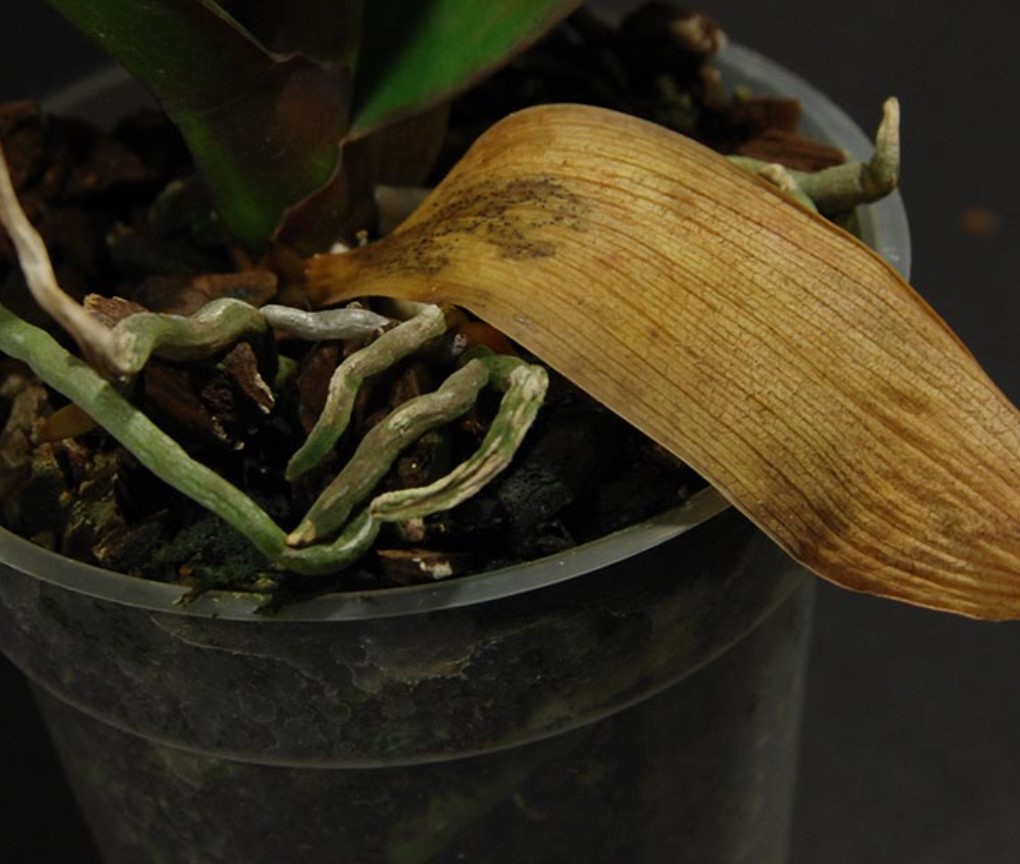
To avoid overwatering your orchid, you should check the moisture level of the soil before each watering by feeling it with your finger. If it feels damp or moist, then your orchid does not need to be watered. Overwatering can also be avoided by ensuring the container has suitable drainage holes and the right potting mix is used that will allow water to pass easily through it.
Be sure to monitor the health of your orchid’s roots regularly and check for signs of trouble such as discoloration, sogginess and rot. Taking these steps will help to ensure your orchid has healthy roots for years to come.
How to Fix an Overwatered Orchid
An overwatered orchid is a common problem for many orchid owners, but it doesn’t have to be the end of the line. With the right steps and a bit of attention, it’s possible to save your overwatered orchid and restore its health.
The first step is to check the condition of the roots.
Allow Roots to Dry Out and Check for Signs of Root Rot
Reviving an overwatered orchid requires some patience and careful attention. The first step is to allow the roots to dry out, which may take a few days. It’s important to refrain from watering during this time frame in order to promote more efficient water absorption. After allowing the roots of the orchid to dry, it is then essential to check for signs of root rot.
To do this, carefully remove the orchid from its container and examine the roots. Signs of root rot are dark brown or black mushy roots. If any such damage is found, use sterilized scissors to snip off the damaged sections of roots. With these steps, you should be able to revive your overwatered orchid.
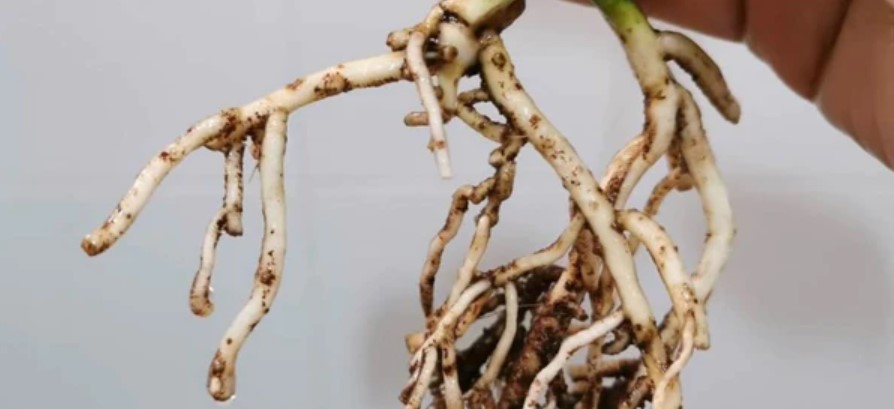
If the roots are not too damaged, adjusting your watering schedule and allowing the plant to dry out may be all that’s needed. Ultimately, continuing to monitor your orchid’s health is essential in order to ensure it remains healthy and thriving!
In summary, reviving an overwatered orchids involves allowing the roots to dry out, checking for signs of root rot and removing damaged sections if necessary, as well as adjusting your watering schedule. With these steps, you should be able to revive your orchid and keep it thriving!
In addition, don’t forget to check for other potential issues such as pests and diseases that may have caused the overwatering. By following these steps, you can save your orchid from an untimely death!
Adjust Watering Schedule
The best way to adjust a watering schedule for phalaenopsis orchids is to get to know the particular type of orchid you have and its specific needs. The environment in which it is kept should also be taken into account. For example, if your orchid is in a very dry environment, it may need more frequent watering.
If you saw minimal root rot, it could be an indication that your orchid is being over-watered. Adjusting the schedule to water less frequently can help prevent further root rot from occurring.
Generally, orchids should only be watered once every 7 to 10 days (or however often is appropriate for its particular needs). This can help ensure the orchid is not over-watered and that its roots are healthy. Adjusting the watering schedule can be an effective way to prevent and treat root rot in orchids.
Taking care when watering your orchid is essential for keeping it healthy and thriving. Adjusting the watering schedule according to its needs and the environment it is kept in can help ensure your healthy orchid roots remain healthy.
In addition to adjusting the watering schedule, make sure you pay attention to any changes in your orchid’s condition and take appropriate action as necessary. By doing so, you can keep your orchid happy and healthy for years to come!
Repot an Orchid & Change Potting Medium
If your orchid’s roots have been affected by root rot, it is important to take the necessary steps to ensure its survival. Repotting and changing the potting medium will give your overwatered orchid leaves the best chance of making a full recovery. Repotting an orchid involves several steps, which are outlined below:
- Gently remove the orchid from its container. Be careful not to damage the roots in the process.
- Remove any potting medium from the roots, and discard the potting medium in the container.
- Trim off any roots that have rotted with a sterilized pair of scissors.
Check Orchid Pot for Adequate Drainage Holes
When it comes to orchids, an adequate drainage system is essential for their health and wellbeing. Without adequate drainage, orchids can suffer from overwatering, root rot, and other problems associated with excess water. The key to avoiding this is to make sure your orchid pot has enough holes in the bottom to allow the water to escape.
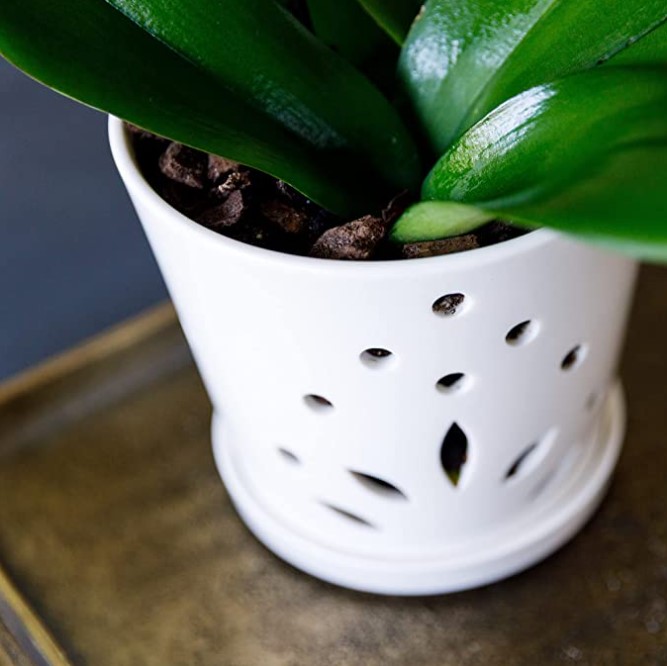
When selecting an orchid pot, look for one with multiple drainage holes—four is a good minimum number, but larger pots should have more. Make sure the holes are not blocked by any objects that may be in the pot during repotting. Check periodically for debris and other materials wedged into the holes and remove them as needed.
By taking the time to make sure your orchid pot has adequate drainage, you’ll be helping your orchid thrive and preventing overwatering in the future. Check your pot now to ensure your orchid is getting the best care possible!
How to Prevent Overwatered Orchid Leaves
One way to prevent your orchid leaves from becoming overwatered is by understanding the plant’s needs. It’s important to know how often to water your orchid and how much water it requires, as this can vary depending on the species.
Generally speaking, an orchid will need watered every 7-10 days and prefers water that has been warmed to room temperature. Additionally, it’s important to check the soil before watering. If the top inch of soil feels dry, it is likely time to water your orchid.
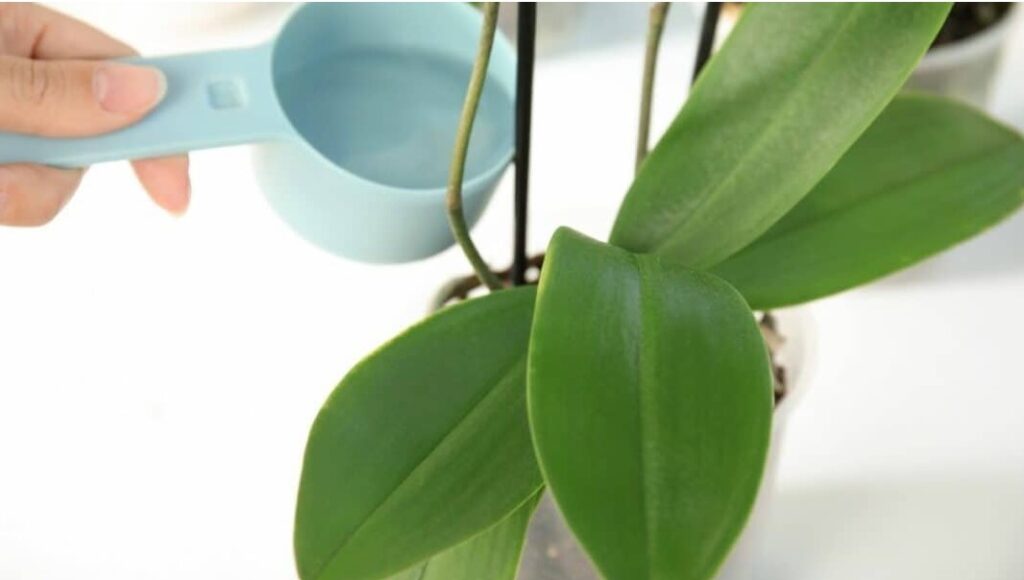
Another way to prevent overwatering your orchid is by choosing an appropriate potting medium for the plant. Orchids prefer loose and well-draining soil, such as a bark and sphagnum moss mix.
This type of potting medium will ensure that the plant’s roots don’t stay waterlogged. Additionally, make sure your pot has good drainage holes to allow excess water to escape.
How to Tell if Your Orchid Needs Watering
Watering an orchid is a delicate balance. Too much water can cause root rot and fungal infections, while too little water will let the plant to wilt and eventually die. When it comes time to water your orchid, there are a couple of ways to tell if it needs more moisture.
The first way to tell if your orchid needs water is to check the growing medium. Orchids generally need to be watered just before their growing medium dries out completely, so you should stick your finger (or a skewer) into the growing mix and feel for moisture.
How dry it should be will depend on the type of orchid and its specific needs, so make sure you know what your orchid requires.
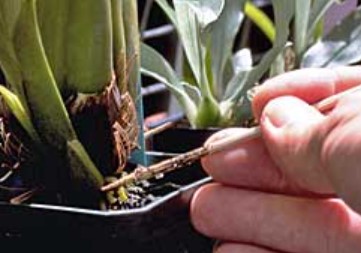
The second way to tell if your orchid needs water is to check the root system. Healthy roots should be firm and white in color, while dry roots look brown and shriveled up. If your orchid’s root system looks dry, it’s time to give it a drink.
Overall, the best way to ensure that your orchid gets the right amount of water is to keep an eye on both signs and regularly check for moisture in the growing medium and aerial roots. Doing this will help you avoid over- and underwatering your plant, ensuring that it stays healthy and happy!
How to Water an Orchid
Watering an orchid is a delicate process that requires a certain amount of precision. Orchids do not like to be overwatered, as this can cause root rot. It’s important to make sure that the roots are able to absorb the water evenly, and for this reason it is best to use lukewarm water.
This ensures that the roots won’t be shocked by cold water. There are two common methods for watering an orchid: running water over it and using a cup.
How Often Should I Water My Orchid?
Watering your orchid correctly is key to keeping it healthy and blooming. How often you should water your orchid depends on several factors. Firstly, different types of orchids have different water requirements.
Some orchids prefer more frequent watering (every 5-7 days) while others do better with less frequent intervals (every 10-14 days). The environment and season also come into play. In the summer months, your orchid is likely to need more frequent watering than in the winter.
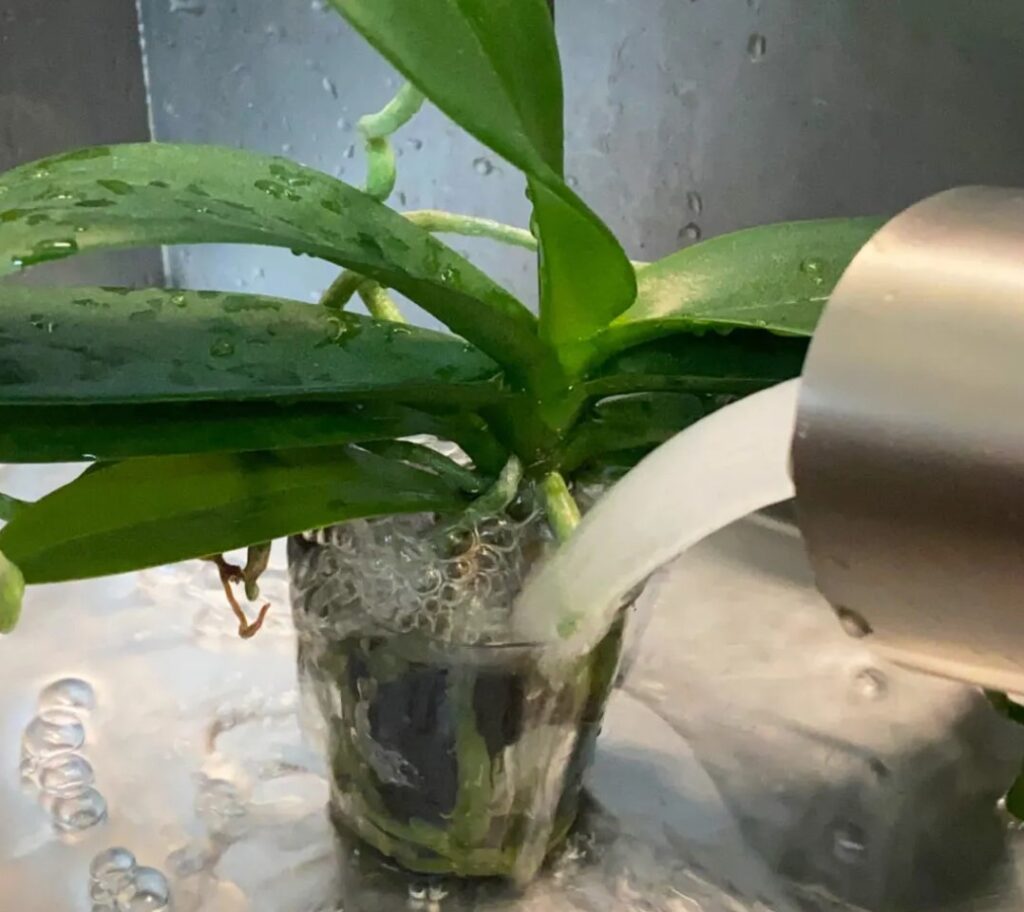
Other factors to consider are the size of the container and type of growing medium. Generally, a larger container will require more frequent watering than a smaller one, as it dries out more quickly. The same applies to the type of growing medium. For instance, sphagnum moss will need more frequent watering than bark or other alternatives.
It may take some time and trial and error before you get a feel for how often your specific orchid will require watering. Until then, use the growing medium as a guide to determine when your orchid needs watering. With the right care, your orchid should continue to thrive and bloom!
Answers on questions:
Can orchids recover from overwatering?
Yes, it is possible for orchids to recover from overwatering if the problem is identified early and action is taken quickly. The first step to care for an overwatered orchids is to gently remove the plant from its pot and inspect the roots for any signs of damage. If any of the roots appear mushy or discolored, gently remove them using a sharp, sterile knife and discard.
Next, repot the orchid in fresh potting media following the orchid repotting instructions provided on our website. By providing proper care and attention, your overwatered orchids may be able to recover from its ordeal.
Should I cut off mushy orchid leaves?
If you notice a mushy or rotten leaf on your orchid, it is important to remove it as soon as possible. In order to ensure that the infection does not spread to other plants, it is best to use sterilized scissors or knives when removing the affected leaf.
The reason for this is because spores and bacteria can easily transfer from one plant to another if the cutting tool is not sterilized.
Furthermore, make sure you discard the leaf in a safe manner as well to avoid any potential contamination. Should you have multiple orchids that seem to be infected, make sure you take steps to disinfect your pruning tools between plants in order to prevent further spread of disease.
By following these steps, you can help keep your orchid collection healthy. To answer the question: Should I cut off mushy orchid leaves? The simple answer is yes, but make sure to follow the proper precautions in order to prevent spreading disease.
Why are my orchid leaves limp and wrinkled?
Wrinkled or limp leaves on an orchid can be a disheartening sight, as these tropical beauties need specific care to thrive and bloom. Wrinkled leaves are usually caused by one of two issues: underwatering the plant or overwatering it and causing root rot.
When an orchid is not receiving enough water, the leaves become limp and wrinkled in an effort to seek out additional moisture. In order to remedy this, check the soil’s moisture level frequently and thoroughly water your orchid until it runs out of the pot’s bottom drainage holes. Avoid letting the plant sit in a pool of excess water as this can lead to root rot. Read also…
Can orchids recover from overwatering?
Orchids can recover from overwatering if the problem is caught early and the plant is given the appropriate care. Overwatering can cause root rot, which can be fatal if not addressed quickly. To help an overwatered orchid recover, it is important to remove any standing water from the pot, allow the soil to dry out, and adjust the watering schedule to prevent future overwatering.
How do you dry an overwatered orchid?
To dry an overwatered orchid, start by removing the orchid from its pot and carefully examining the roots for signs of rot. If there is any rot, trim off the affected roots with a clean, sharp pair of scissors or pruning shears. Then, allow the orchid to air dry in a cool, shaded area for several hours, until the roots are no longer wet to the touch. Once the orchid has dried out, repot it in fresh, well-draining potting mix, and adjust the watering schedule to prevent future overwatering.
How do I know if my orchid has too much water?
You can tell if your orchid has too much water if the potting mix is consistently wet or soggy, the roots are soft and discolored, the leaves are yellowing or turning brown, there is a lack of new growth, or there is a buildup of salt or mineral deposits.
What do the leaves of an overwatered orchid look like?
The leaves of an overwatered orchid may turn yellow and feel soft and mushy to the touch. Additionally, there may be signs of root rot, such as black or brown roots.
Should I cut wrinkled orchid leaves?
It depends on the reason for the wrinkling. If the leaves are wrinkled due to underwatering, you should water your orchid and wait for the leaves to plump up before deciding to cut them. If the leaves are wrinkled due to overwatering or another issue such as pest infestation or disease, you should address the underlying issue first before considering cutting the leaves.
Should I spray my orchid with water?
Yes, you can spray your orchid with water, but it’s better to water it at the roots instead of the leaves. The best way to water an orchid is to place it in a bowl of water and let it soak for about 10-15 minutes, then remove it from the water and let it drain completely.
Why are my orchid leaves soft and floppy?
Soft and floppy leaves on an orchid can be a sign of overwatering or root rot, as well as insufficient light or high humidity. It’s important to check the roots for any signs of damage or decay and adjust your watering routine accordingly.

